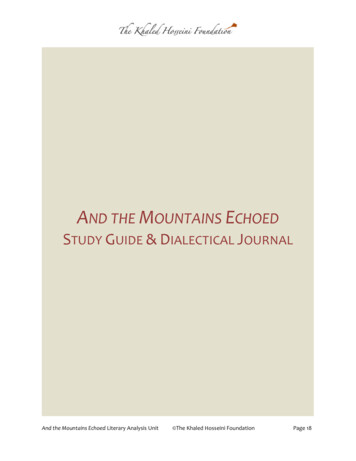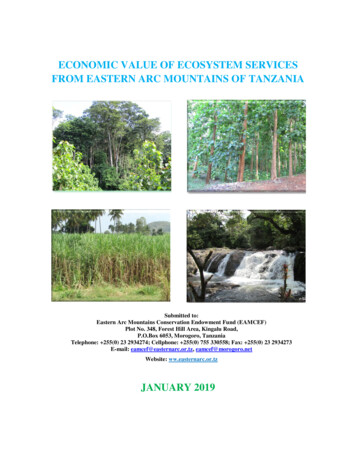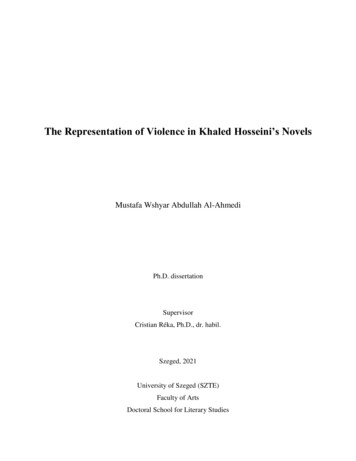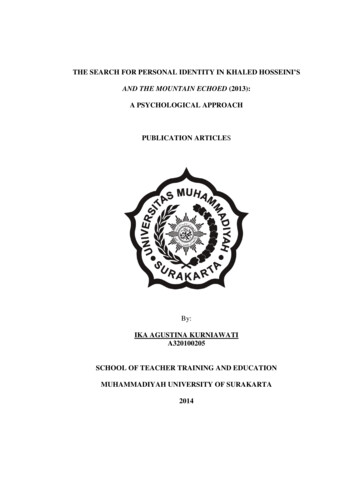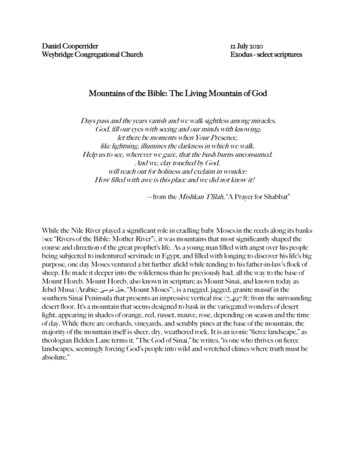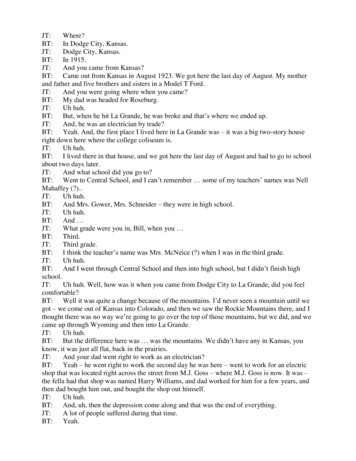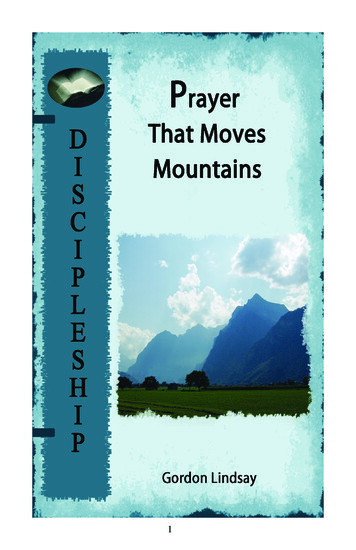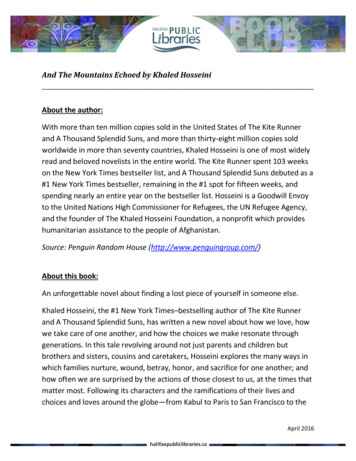
Transcription
And The Mountains Echoed by Khaled HosseiniAbout the author:With more than ten million copies sold in the United States of The Kite Runnerand A Thousand Splendid Suns, and more than thirty-eight million copies soldworldwide in more than seventy countries, Khaled Hosseini is one of most widelyread and beloved novelists in the entire world. The Kite Runner spent 103 weekson the New York Times bestseller list, and A Thousand Splendid Suns debuted as a#1 New York Times bestseller, remaining in the #1 spot for fifteen weeks, andspending nearly an entire year on the bestseller list. Hosseini is a Goodwill Envoyto the United Nations High Commissioner for Refugees, the UN Refugee Agency,and the founder of The Khaled Hosseini Foundation, a nonprofit which provideshumanitarian assistance to the people of Afghanistan.Source: Penguin Random House (http://www.penguingroup.com/)About this book:An unforgettable novel about finding a lost piece of yourself in someone else.Khaled Hosseini, the #1 New York Times–bestselling author of The Kite Runnerand A Thousand Splendid Suns, has written a new novel about how we love, howwe take care of one another, and how the choices we make resonate throughgenerations. In this tale revolving around not just parents and children butbrothers and sisters, cousins and caretakers, Hosseini explores the many ways inwhich families nurture, wound, betray, honor, and sacrifice for one another; andhow often we are surprised by the actions of those closest to us, at the times thatmatter most. Following its characters and the ramifications of their lives andchoices and loves around the globe—from Kabul to Paris to San Francisco to theApril 2016
Greek island of Tinos—the story expands gradually outward, becoming moreemotionally complex and powerful with each turning page.Source: Author’s Website (http://khaledhosseini.com/)Discussion Questions:1. And the Mountains Echoed introduces us to Saboor and his childrenAbdullah and Pari, and the shocking, heartbreaking event that dividesthem. From there, the book branches off to include multiple othercharacters and storylines before circling back to Abdullah and Pari. How doeach of the other characters relate back to the original story? What themesis the author exploring by having these stories counterpoint one another?2. The novel begins with a tale of extraordinary sacrifice that hasramifications through generations of families. What do you think ofSaboor’s decision to let the adoption take place? How are Nila and Nabiimplicated in Saboor’s decision? What do you think of their motives? Whodo you think is the most pure or best intended of the three adults?Ultimately, do you think Pari would have had a happier life if she hadstayed with her birth family?3. Think of other sacrifices that are made throughout the book. Are therecertain choices that are easier than others? Is Saboor’s sacrifice when heallows Pari to be adopted easier or more difficult than Parwana’s sacrificeof her sister? How are they similar and how are they different? Who elsemakes sacrifices in the book? What do you think the author is saying aboutthe nature of the decisions we make in our lives and the ways in which theyaffect others?April 2016
4. “Out beyond ideas of wrongdoing and rightdoing, / there is a field. I’ll meetyou there.” The author chose this thirteenth-century Rumi poem as theepigraph for the book. Discuss the novel in light of this poem. What do youthink he is saying about rightdoing and wrongdoing in the lives of hischaracters, or in the world?5. The book raises many deep questions about the wavering line betweenright and wrong, and whether it is possible to be purely “good”—or purely“bad.” What do you think after reading the novel: Are good intentionsenough to create good deeds? Can positive actions come from selfishmotivations? Can bad come from positive intent? How do you think thisnovel would define a good person? How would you define one?6. Discuss the question of wrongdoing and rightdoing in the context of thedifferent characters and their major dilemmas in the book: Saboor and hisdaughter Pari; Parwana and her sister, Masooma; the expats, Idris andTimur, and the injured girl, Roshi; Adel, his warlord father, and theirinteractions with Gholam and his father (and Abdullah’s half brother), Iqbal;Thalia and her mother. Do any of them regret the things they have done?What impact does it have on them?7. The overlapping relationships of the different characters are complex andreflective of real life. Discuss the connections between the differentcharacters, how they are made, grow, and are sustained. Consider all theways in which an event in one of the families in the book can resonate inthe lives of so many other characters. Can you name some examples?8. Saboor’s bedtime story to his children opens the book. To what degreedoes this story help justify Saboor’s heart-wrenching act in the nextchapter? In what ways do other characters in the novel use storytelling toApril 2016
help justify or interpret their own actions? Think about your ownexperiences. In what ways do you use stories to explain your own past?9. Two homes form twin focal points for the novel: the family home ofSaboor, Abdullah, and Pari—and later Iqbal and Gholam—in Shadbagh; andthe grand house initially owned by Suleiman in Kabul. Compare the homesand the roles they play in the novel. Who has claims to each house? Whatare those claims based on? How do the questions of ownership complicatehow the characters relate to one another?10. The old oak tree in Shadbagh plays an important role for many differentcharacters (Parwana, Masooma, Saboor, Abdullah, and Pari) during its life.What is its significance in the story? What do its branches represent? Whydo you think Saboor cuts it down? How does its stump come back as animportant landmark later on?11. In addition to all of the important family relationships in the book, thereare also many nongenetic bonds between characters, some of them just asstrong. Discuss some of these specific relationships and what needs theyfill. What are the differences between these family and nonfamily bonds?What do you think the author is trying to say about the presence of theserelationships in our lives?12. And the Mountains Echoed begins in Afghanistan, moves to Europe andGreece, and ends in California, gradually widening its perspective. What doyou think the author was trying to accomplish by including so manydifferent settings and nationalities? What elements of the characters’different experiences would you say are universal? Do you think thecharacters themselves would see it that way?April 2016
13. Discuss the title, And the Mountains Echoed, and why you think it waschosen. Can you find examples of echoes or recurrences in the plot? In thestructure of the storytelling?Source: Author’s Website (http://khaledhosseini.com)Other formats available at Halifax Public Libraries:- Audiobook (on CD)- eBook- Large PrintApril 2016
And The Mountains Echoed by Khaled Hosseini _ About the author: With more than ten million copies sold in the United States of The Kite Runner and A Thousand Splendid Suns, and more than thirty-eight million copies sold worldwide in more than seventy countries, Khaled Hosseini is one of most widely .


